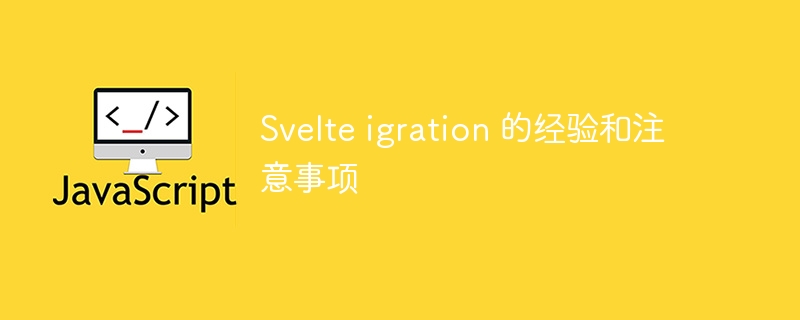
我最近更新了一个相当复杂的网络应用程序。该应用具有 auth、stripe、i18n、dark/light 模式、pwa 等功能。总体而言,它有大约 30 个页面和组件,几乎没有第三方 npm 包。
我想指出在将应用程序迁移到 svelte 5 时我发现非常具有挑战性的事情。
svelte 提供的自动迁移脚本可以在终端 npx sv migrate svelte-5 中使用这个“one-liner”命令为您完成这项工作(在完成所有必要的更新并安装之后:“@sveltejs/vite -plugin-svelte”:“^4.0.0”和“svelte”:“^5”)。但我并不推荐这种“锤子”的做法。
使用 ctrl + shift + p (windows/linux) / shift + command + p (mac) 逐个文件、逐个组件地进行操作,并使用“将组件迁移到 svelte” 5 vs code 命令面板中的语法命令改为。这样你就会有更多的控制权。
脚本无法创造奇迹。将反应式变量声明升级到 $state() 通常没问题。然而,脚本可能很难检测 $: 是否应该转换为 $driven()/$衍生.by(() => {}) 或 $effect(() => {})。
那么,你猜怎么着?使用自动迁移脚本,您最终可能会得到大量 run(() => {})。
例如,想象一个使用如下内容的简化示例:
<script>
...
let notext = false;
$: if (data.completedoc == 'nolangversion') {
notext = true;
}
$: if (data.completedoc !== 'nolangversion') {
notext = false;
}
</script>
...
{#if notext}
{data.userprefferedlang.notextwarning}
{:else}
...
{/if}
...
自动迁移脚本将为您提供:
<script>
import { run } from 'svelte/legacy';
...
let notext = $state(false);
run(() => {
if (data.completedoc == 'nolangversion') {
notext = true;
}
});
run(() => {
if (data.completedoc !== 'nolangversion') {
notext = false;
}
});
</script>
有一个很好的小警告,run 函数已被弃用。
我猜更好的 svelte 5 代码是这样的:
<script>
...
let notext = $derived.by(() => {
if (data.completedoc == 'nolangversion') {
return true;
}
if (data.completedoc !== 'nolangversion') {
return false;
}
});
...
</script>
或者如果你的代码并不复杂,即使是这样:
<script>
...
let notext = $derived(
data.completedoc == 'nolangversion'
?
true
:
false
)
...
</script>
原因是脚本无法轻松地将代码转换为 $categories.by(() => {}),因此它想使用更脏的方法 $effect()。但 $effect() 仅在客户端运行,因此该脚本使用已弃用的 run 函数。
现在我们得到了最重要的结论。 $effect() 仅在客户端运行。因此,服务器上没有用于预渲染页面和 ssr 的 $effect()。
$effect() 不在服务器上运行!
svelte 5 文档中应该强调这一点。
看这两个例子:
<script>
let a = 1
let b = 2
$: c = a + b
</script>
{c} // server responds with c == 3
<script>
let a = $state(1)
let b = $state(2)
let c = $state(0)
$effect(() => {
c = a + b
})
</script>
{c} // server responds with c == 0
它们不一样。这带来了很多挑战。客户端在安装页面时需要重新评估 c 变量。从服务器发送的页面和最终在客户端上进行 dom 渲染时的页面看起来会有所不同(ssr、seo、闪烁问题等)。
因此,请始终尝试使用 $衍生或 $衍生.by(() => {}) 而不是 $effect()。这会为你省去很多麻烦。
这与我们被劝阻不要在 sveltekit 和 ssr 中使用商店时的情况完全相同。
由于 svelte 5 到来期间给出的示例,您可能会想用 $effect() 替换 sveltekit 中的 onmount() 。由于已经提到的原因,我暂时不鼓励这样做。 onmount 仍然是核心 svelte 生命周期挂钩。
另一个令人惊喜的地方是 svelte 5 非常注意变量值的一致性。如果您将变量作为 prop 传递给组件,并稍后在组件中更改此变量,脚本将尝试使用 $bindable $prop 解决此不一致问题。应通知家长,以便您的应用程序状态保持一致。
看这个例子:
// parent svelte file
<script>
import componentbinded from './componentbinded.svelte';
import componentwithderived from './componentwithderived.svelte';
let name = $state('john wick');
</script>
<p>name value in parent: {name}</p>
<componentbinded bind:name={name} />
<componentwithderived {name} />
自动迁移脚本将要求您使用具有绑定值的组件,以确保父级可以取回更新的值:
// componentbinded.svelte
<script>
let { name = $bindable() } = $props();
name = name.touppercase()
</script>
<p>
name value in component with binded value: {name}
</p>
但也许我们也可以使用更简单的方法,你猜对了,使用 $衍生():
// componentwithderived.svelte
<script>
let { name } = $props();
let uppercasename = $derived(name.touppercase())
</script>
<p>
name value in component with derived value: {uppercasename}
</p>
我在迁移过程中发现的一个非常好的功能是我们现在可以使用 css :global 和 block。例如,如果您想在 @html 中设置 html 元素的样式,则使用 :global 进行样式设置是非常必要的。
所以代替这个:
...
<style>
#blog :global(table) {
width: 100%;
}
#blog :global(td) {
text-align: left;
}
#blog :global(th) {
font-weight: bolder;
font-size: medium;
text-align: center;
}
</style>
你可以使用这个:
...
<style>
#blog :global {
table {
width: 100%;
}
td {
text-align: left;
}
th {
font-weight: bolder;
font-size: medium;
text-align: center;
}
}
</style>
在 svelte 4 中,如果您想提供 css 类作为组件的 prop,您可以使用 {$$props.class}:
// icons component
<script>
export let name;
export let width = '1.5em';
export let height = '1.5em';
export let focusable = false;
let icons = {
user: {
svg: `<path fill="none" d="m0 0h24v24h0v0z"/><path d="m12 6c1.1 0 2 .9 2 2s-.9 2-2 2-2-.9-2-2 .9-2 2-2m0 10c2.7 0 5.8 1.29 6 2h6c.23-.72 3.31-2 6-2m0-12c9.79 4 8 5.79 8 8s1.79 4 4 4 4-1.79 4-4-1.79-4-4-4zm0 10c-2.67 0-8 1.34-8 4v2h16v-2c0-2.66-5.33-4-8-4z"/>`
},
user_logged: {
svg: `<path fill="none" d="m0 0h24v24h0z"/><path d="m12 12c2.21 0 4-1.79 4-4s-1.79-4-4-4-4 1.79-4 4 1.79 4 4 4zm0 2c-2.67 0-8 1.34-8 4v2h16v-2c0-2.66-5.33-4-8-4z"/>`
}
};
let displayicon = icons[name];
</script>
<svg
xmlns="http://www.w3.org/2000/svg"
class={$$props.class}
viewbox="0 0 24 24"
fill="currentcolor"
{focusable}
{width}
{height}
>
{@html displayicon.svg}
</svg>
<style>
...
</style>
在 svelte 5 中你可以使用 class={classname}:
<script>
let {
name,
width = '1.5em',
height = '1.5em',
focusable = false,
class: className = ''
} = $props();
let icons = {
user: {
svg: `<path fill="none" d="M0 0h24v24H0V0z"/><path d="M12 6c1.1 0 2 .9 2 2s-.9 2-2 2-2-.9-2-2 .9-2 2-2m0 10c2.7 0 5.8 1.29 6 2H6c.23-.72 3.31-2 6-2m0-12C9.79 4 8 5.79 8 8s1.79 4 4 4 4-1.79 4-4-1.79-4-4-4zm0 10c-2.67 0-8 1.34-8 4v2h16v-2c0-2.66-5.33-4-8-4z"/>`
},
user_logged: {
svg: `<path fill="none" d="M0 0h24v24H0z"/><path d="M12 12c2.21 0 4-1.79 4-4s-1.79-4-4-4-4 1.79-4 4 1.79 4 4 4zm0 2c-2.67 0-8 1.34-8 4v2h16v-2c0-2.66-5.33-4-8-4z"/>`
}
};
let displayIcon = icons[name];
</script>
<svg
xmlns="http://www.w3.org/2000/svg"
viewBox="0 0 24 24"
fill="currentColor"
class={className}
{focusable}
{width}
{height}
>
{@html displayIcon.svg}
</svg>
<style>
...
</style>
当我使用自动合并脚本时,我对应用程序的性能下降感到震惊。有了 svelte 4,我几乎获得了 100% 的成绩。直到我手动迁移并仔细考虑如何(主要是如果可能的话如何避免 $effect())后,我的 lighthouse 分数才再次回到绿色。
迁移到 svelte 5 的时间比我预期的要长。不过,我还没有将这个新版本投入生产。 svelte 5 的更新频率仍然相当高。
希望我的经验对其他人有用。
以上就是Svelte igration 的经验和注意事项的详细内容,更多请关注php中文网其它相关文章!

每个人都需要一台速度更快、更稳定的 PC。随着时间的推移,垃圾文件、旧注册表数据和不必要的后台进程会占用资源并降低性能。幸运的是,许多工具可以让 Windows 保持平稳运行。

Copyright 2014-2025 https://www.php.cn/ All Rights Reserved | php.cn | 湘ICP备2023035733号